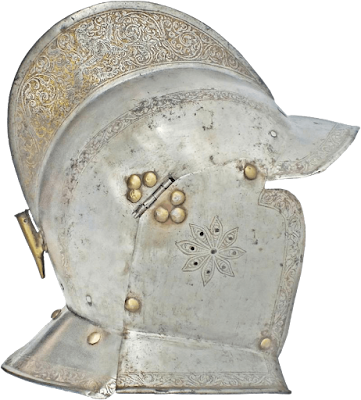The Heritage of European Arms & Armor
Collectors of antique arms and armor are in good company.
Historically associated with wealth and power, most royal families had a
passion for arms and armor generating family collections along with private
arsenals- many of which lasted into the 19th Century and some of which are
intact today. Individual collectors include such notables as Rembrandt,
Napoleon, William Randolph Hearst and Herman Groening. Today a broad spectrum
of examples in held in private hands, while a diverse collecting interest seems
the most rewarding, several specialists have emerged. Armor evolved to full
body encasement in the 15th Century and fell into disuse in the 17th Century
with the increasing efficiency of firearms. A full armor- the archaic term
“suit of armor” is no longer preferred – has a presence and personality about
it derived from its anatomical form and ultimately personal use. Like the
vacated shell of a tarantula, the armor is the warrior absent the man.
Homogeneous armors are quite rare, the majority of them having been altered in
the 17th Century and restored in the 19th Centuries. Of surviving individual
elements, helmets, understandably are the most valued by collectors.

Antique arms include the weapons of the warrior and the hunt
as well as arms necessary for personal protection. The latter includes a
variety of swords which evolved from military types and changed with fashion
from rapier to smallsword. Military officers, who were not expected to fight,
generally carried smaller swords into battle. Numerous examples from the
plainest and mass produced to elegant silver, gold, and jewel mounted arms of
the wealthy are available to the collector today.
Like personal arms, military swords show a constantly
changing form in response to changing military tactics. The symmetrical
cruciform sword of the 15th Century Knight had no need to provide protection
for his armored hand. As armor was used more selectively, swords with a variety
of handguards were produced reaching their epitome in the Scottish basket hilt
broadsword of the Scottish Rebellion, circa 1715. The effectiveness of a
lightly protected and highly mobile cavalryman was learned at great cost in the
16th Century. From the Ottoman Turks and specialized swords evolved with hand
guards and long blades, both straight and curved, which could effectively
deliver a fatal blow from horseback. With the increasing efficiency of cannon,
the importance of naval power grew throughout the period and specialized
weapons for ship boarding evolved. Ships were drawn together by grappling hooks
whose lines could be cut on the rails with boarding axes, which also served as
weapons. Simultaneously, boarding pikes were used to repel the boarders. The
naval cutlass with its short blade evolved for the extremely close quarters
fighting on ships decks. As seamen were often impressed into service against
their wishes, all weapons were kept in locked storage until a battle was
imminent. As an integral part of the ships stores they were often marked with
the name of the ship in which they served adding a provocative historical note
for the collector. The 19th Century brought dramatic changes in weaponry and
its use with edged weapons (sword and lance) used to great effect in the
Crimean War and Sepoy Rebellion, and slightly later in the Civil American War.
As with most change, the transition was gradual but, owing to the economical
production of increasingly sophisticated firearms with minor exceptions, the
sword became a symbol of authority to be used as a last resort after that time.
The concept of hunting in Europe as it was practiced prior
to the Industrial Revolution is often misunderstood today. At that time, the
production of cereal crops was too labor intensive to allow their use for
animal feed so they were reserved for human consumption. Grazing and foraging
animals (such as pigeons) provided a portion of the meat consumed, but great
hunts in the fall of the year provided a meat harvest for the winter. Game
belonged to the land owner and accordingly, largely to the titles. The hunt was
an elaborate affair steeped in ceremony and, in peace time, served to
demonstrate the prowess of the noble hunter. Bear, deer and boar were engaged
in combat with swords and their carcasses later dismembered with elegant
trousse sets which bore a great resemblance to the surgical instruments of the
time. Equally elegant were the weapons of the hunt, often stocked by the
hundreds in hunting lodges to accommodate large parties of guests. Owing to
their unique relationship with their owners, time has been kind to antique
weapons. Substantial quantities in virtually every field have survived and are
available to collectors today. The products of a society of now extinct
craftsmen, many show skills, artistry and technology beyond the suspicion of
the casual observer. Market values belie their achievements. It is said that
the original cost of a full armor can be compared to the cost of an automobile
today, and, in-fact, current values lie within that range as well. 18th Century
silver hilted swords cost no more than silver candle sticks of the period, and
a 16th Century helmet can be purchased for less than the price of a pewter
charger of the period. Just as the attainability of antique arms and armor is a
benefit of their special place in history, they carry with them an obligation
universally understood by collectors: To study and enjoy but also preserve, as
the baton inevitability must be passed.


Comments
Post a Comment